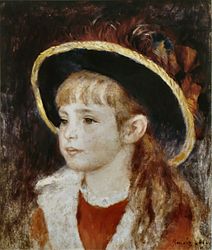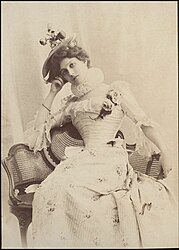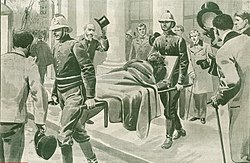Jane Henriot
Jane Henriot | |
|---|---|
 Jane Henriot | |
| Born | Jeanne Angèle Grossin 28 April 1878[1] 21 rue de la Tour d'Auvergne, 9th arrondissement of Paris |
| Died | 8 March 1900 (aged 21)[1] |
| Cause of death | Suffocated and asphyxiated due to fire |
| Burial place | Passy Cemetery, 16th arrondissement of Paris[1] 48°51′45″N 2°17′07″E / 48.86250°N 2.28528°ECoordinates: 48°51′45″N 2°17′07″E / 48.86250°N 2.28528°E |
| Nationality | French |
| Education | Conservatoire de musique et de déclamation |
| Occupation | Actress and model |
| Known for | Actress in Comédie-Française |
| Partner(s) | Charles le Bargy |
| Parent(s) |
|
Jane Henriot (born Jeanne Angèle Grossin 28 April 1878 – 8 March 1900)[1] was an actress at the Comédie-Française and a model for the French artist Pierre-Auguste Renoir posing in Fillette au chapeau bleu (English: Little girl in blue hat) in 1881 when she was a child. She died having suffocated and asphyxiated in an explosion and fire at the Comédie-Française having tried to save her little dog.
Early life[]
Henriot was born in 21 Rue de la Tour-d'Auvergne, 9th arrondissement of Paris, Île-de-France, France. Her mother Marie Henriette Alphonsine Grossin was also an actress and model for Renior. Henriot used the same surname as a stage name as her mother, who was known as Henriette Henriot.
She studied at the Conservatoire d’art dramatique de Paris.[2] where she became the mistress of actor and director Charles le Bargy,[2] who was her professor at the time.[2] He eventually left her to marry Madame Simone, who was no happier with her than he had been with Henriot.[3]
Professional career[]
Henriot posed for the French artist Pierre-Auguste Renoir in the painting Fillette au chapeau bleu (English: Little girl in blue hat) in 1881 when she was still a child.[4]
Henriot made her debut at the Comédie-Française as a leading actress as Myrtha in La Douceur de croire by Jacques Normand on 8 July 1899.[2] Le Monde artiste remarked Henriot was a "little dreamlike and charming infant whose sweet voice made one think of the chirping of birds, a delicious creature, very cute in its juvenile grace" (March 11, 1900, p. 156). She was loved by both the public and critics.
Stage career[]
Plays that Henriot acted in at the Comédie-Française from 8 July 1899:
- Myrtha in La Douceur de croire by Jacques Normand
- Sylvette in Les Romanesques by Edmond Rostand
- Hippolyta (Hippolyte) in L'Étourdi ou les Contretemps by Molière
- Bertrade in Grisélidis by Armand Silvestre and Eugène Morand.
- Lucile in Le Dépit amoureux by Molière
- Isabelle in Le Légataire universel by Jean-François Regnard
- Lucinde in Le Médecin malgré lui by Molière
- Céphise in Andromaque by Jean Racine
- Juliette in Diane de lys by Alexandre Dumas fils
- Zaïre in Bajazet by Jean Racine, which she played from 1 March 1900 until her death.
Death, funeral and memorial service[]

Just before noon on 8 March 1900, after a matinee where she was playing the role of the confidant Zaïde in Jean Racine's play Bajazet at the Comédie-Française, an explosion and fire broke out.[5] Henriot was on the fourth floor of the theater.[4] Her dresser had a better knowledge of place and could find her own way out and through a window.[4] Mary Marquet told her to get out of the fire, however Henriot was trying to find her little dog, which was a gift from Le Bargy, whom she had recently broken-up with.[4] Henriot was still wandered around the building when she died of asphyxiation.[4] Her body was later found, but it was unrecognisable, her face blackened, burnt hair and body convulsed.[4] Her mother identified the body in the morgue.[4]
Two days later, a large crowd gathered at her funeral, and the convoy passed through Paris to the church of Saint-Honoré-d'Eylau, the Montmartre cemetery.[4] Shortly after her death, the Comédie-Française wanted a portrait of Henriot.[2] On the advice of her mother, they gave the portrait painter Carolus-Duran the task of making a portrait of Henriot, having previous painted another actress Jeanne Samary in 1885.[2] Carolus-Duran had known Henriot and was inspired by the photographs taken by Reutlinger, which were published on postcards.[2]
A year after her death on 8 March 1901, a memorial service was held in Saint-Roch, Paris,[4] where her friends went to her tomb which was sculpted by Denys Puech above a white marble monument by the architect Marcel Dourgnon with the following words having been engraved on the base of the tomb: "À Jane Henriot, la Comédie-Française" (English: To Jane Henriot, the French-Comedy),[4] with an inscription taken from an article by Émile Faguet: ...Elle est venue, Elle a souri, Elle a passé! (English: She came, She smiled, She has passed!)[4]
Gallery[]
Paintings and photographs of Henriot
|
|---|
Henriot's death and funeral
|
|---|
See also[]
References[]
- ^ Jump up to: a b c d "Jane Henriot". The Ark of Grace. 9 June 2012. Retrieved 2020-05-04.
- ^ Jump up to: a b c d e f g h "Jane Henriot (1878-1900), une étoile filante". Marion Doublet. Retrieved 2020-05-04.
- ^ "Jane Henriot, Le Bargy, Madame Simone... Un spectacle au Théâtre Proscenium". Actualitte.com. Retrieved 2020-05-04.
- ^ Jump up to: a b c d e f g h i j k "Pierre-Auguste Renoir "Madame Henriot" 1876 Framed Art Giclée Giclee On Canvas". WorthPoint. Retrieved 2020-05-04.
- ^ "The World at War - France La Belle Époque - Part 2 1900 – 1904". www.schudak.de. Retrieved 2020-05-04.
Sources[]
- Henry Lyonnet, Dictionnaire des comédiens français
External links[]
 Media related to Jane Henriot at Wikimedia Commons
Media related to Jane Henriot at Wikimedia Commons
- 1878 births
- 1900 deaths
- Actresses from Paris
- French child models








